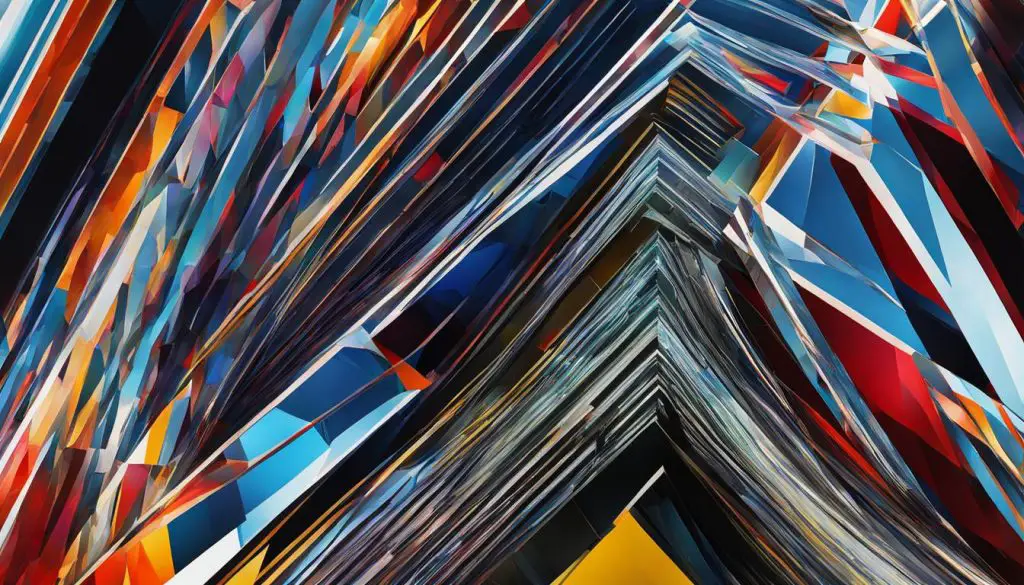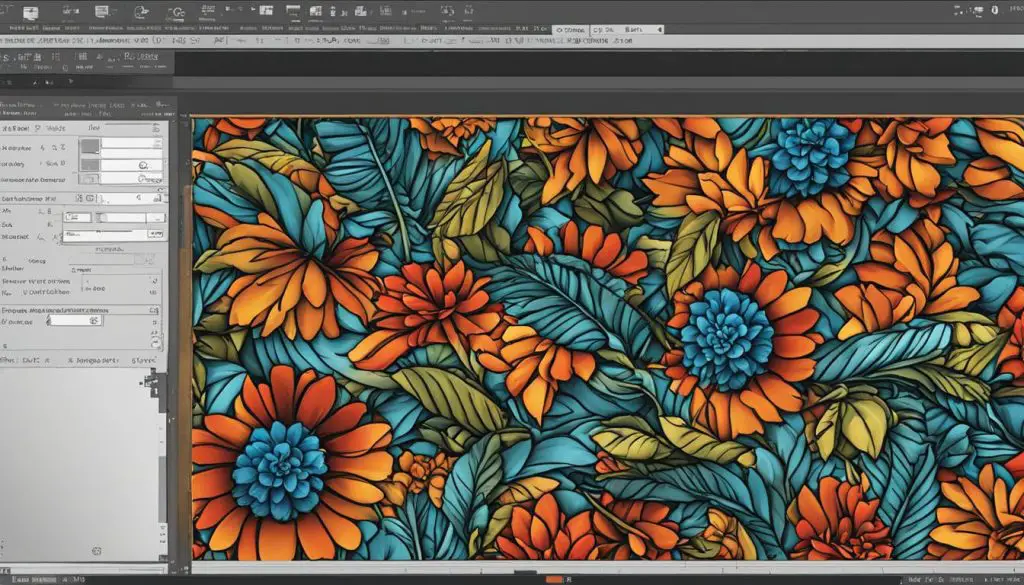Converting a JPEG file to lines in GIMP is a valuable technique for artists and designers looking to create unique line art from their digital images. Whether you want to transform a photograph into a stunning line drawing or create custom line patterns, GIMP provides the necessary tools and features to achieve impressive results.
In this tutorial, we will guide you through the step-by-step process of converting a JPEG file to lines using GIMP. From understanding scan lines to exploring various techniques and settings, you’ll learn how to unleash your creativity and produce professional-looking line art drawings. Let’s dive in!

Key Takeaways:
- Converting JPEG files to lines in GIMP allows you to create unique and artistic line art drawings.
- GIMP offers a range of tools and techniques, such as the Photocopy filter and custom line patterns, for converting JPEGs to lines.
- Following a step-by-step process, you can easily convert JPEG files to lines in GIMP, adjusting settings and applying creative effects.
- Enhance your line art drawings by incorporating layer masking, creative filters, and color curves in GIMP.
- Explore additional resources and support, including tutorials and online communities, to further enhance your skills in converting JPEG files to lines in GIMP.
Understanding Scan Lines in GIMP
Scan lines are a visual element that can be added to images in GIMP to create a distinctive and organized look. They consist of black, grey, diagonal, vertical, or horizontal lines that repeat over the top of the picture. Scan lines can be used to enhance the overall aesthetic of an image and give it a unique artistic effect. In GIMP, you have the flexibility to adjust the size, color, and orientation of the scan lines to suit your artistic vision.
Adding scan lines to your images in GIMP is a simple process. Start by opening the image you want to add scan lines to. Then, create a new layer and select the Line Tool from the toolbox. Choose the desired color and thickness for the scan lines, and draw them over the image. You can experiment with different line patterns and orientations to achieve various effects.
Once the scan lines are in place, you can further customize their appearance by adjusting the opacity and blend mode of the layer. This allows you to blend the scan lines seamlessly with the underlying image, creating a harmonious composition. Additionally, you can use layer masks to selectively apply the scan lines to specific areas of the image, giving you even more control over the final result.
Example of Scan Lines in GIMP
| Image Before | Image After Adding Scan Lines |
|---|---|
 |
As you can see from the example above, the addition of scan lines can significantly transform the look and feel of an image. It adds depth, texture, and visual interest, making the image more visually appealing. Experimenting with different scan line patterns, colors, and opacities can help you achieve the desired artistic effect and make your images stand out.
Converting JPEG to Line Art Using GIMP
GIMP offers a variety of tools and features that make converting a JPEG file to line art a straightforward and creative process. Whether you’re an experienced artist or just starting with digital art, GIMP provides the necessary tools to transform your JPEG files into stunning line drawings.
One of the key features in GIMP for converting JPEG files to line art is the Photocopy filter. This filter analyzes the image and converts it to a black and white representation, emphasizing the lines and contours. You can easily adjust the filter settings to achieve the desired level of detail and line thickness.
In addition to the Photocopy filter, GIMP also allows you to create custom line patterns for a more unique and personalized look. By creating your own pattern brush, you can apply intricate and varied lines to your image, adding depth and complexity to your line art.
Furthermore, GIMP offers the flexibility to adjust blend modes and opacity settings, allowing you to experiment with different styles and effects. By playing with these settings, you can create a range of line art styles, from bold and graphic to subtle and delicate.
Comparison of GIMP Features for Converting JPEG Files to Lines:
| Feature | How It Works | Advantages |
|---|---|---|
| Photocopy Filter | Analyzes the image and converts it to a black and white representation, emphasizing lines and contours. | – Easy to use – Provides control over line thickness and detail – Preserves original image |
| Custom Line Patterns | Create your own patterns to apply intricate and varied lines to your image. | – Allows for a unique and personalized look – Adds depth and complexity to line art |
| Blend Modes and Opacity Settings | Adjust the blend modes and opacity of the line layer to create different styles and effects. | – Offers flexibility and creative freedom – Allows for experimentation with various line art styles |
“GIMP provides a powerful set of tools and features for converting JPEG files to line art. With the Photocopy filter, custom line patterns, and blend modes, you can easily transform your images into stunning line drawings.”
With these features and techniques at your disposal, GIMP enables you to unleash your creativity and produce impressive line art from JPEG files. Whether you’re a digital artist, designer, or hobbyist, GIMP offers a range of possibilities for converting JPEG files to lines and bringing your imagination to life.
Step-by-Step Process for Converting JPEG to Lines in GIMP
Converting a JPEG file to lines in GIMP is a straightforward process that can be accomplished in a few simple steps. Follow this step-by-step guide to transform your JPEG files into stunning line drawings:
- Open GIMP and go to “File” then “Open” to select the JPEG image you want to convert.
- Once the image is open, go to the “Filters” menu and choose “Artistic” then “Photocopy.” Adjust the settings as needed to achieve the desired line effect, such as increasing the detail threshold or decreasing the darkness level.
- To further enhance the line art, you can create custom line patterns. Go to the “Edit” menu and select “Preferences.” In the Preferences window, navigate to “Folders” and click on “Patterns.” Here, you can add your own line patterns or download patterns from online sources.
- To apply a custom line pattern, go to the “Layers” menu and select “New Layer.” Choose “Transparency” as the layer type and click “OK.” Then, select the “Paintbrush” tool and choose the custom line pattern from the Pattern drop-down menu. Use the brush to paint over the areas where you want the custom lines to appear.
- Adjust the blend modes and opacity settings of the layers to blend the line art with the original image. Experiment with different blending options to achieve the desired result.
- Finally, save your converted JPEG file as a line drawing by going to the “File” menu and selecting “Export As.” Choose a file format, such as PNG or JPEG, and save the image to your desired location.
By following these step-by-step instructions, you can easily convert your JPEG files into artistic line drawings using GIMP.
| Step | Description |
|---|---|
| 1 | Open GIMP and navigate to “File” → “Open” to select the JPEG image you want to convert. |
| 2 | Go to the “Filters” menu and choose “Artistic” → “Photocopy.” Adjust the settings to achieve the desired line effect. |
| 3 | Customize line patterns by going to the “Edit” menu → “Preferences” → “Folders” → “Patterns.” Add your own patterns or download them from online sources. |
| 4 | Create a new layer and use the “Paintbrush” tool to apply the custom line pattern to desired areas. |
| 5 | Adjust the blend modes and opacity settings to blend the line art with the original image. |
| 6 | Save the converted JPEG file as a line drawing by going to the “File” menu and selecting “Export As.” |
Converting a JPEG file to lines in GIMP is a relatively easy process, and with a little practice, you can create stunning line art from your digital images. By following this step-by-step process, you can unleash your creativity and transform ordinary photographs into unique and artistic line drawings. Experiment with different settings, patterns, and blending options to achieve the desired effect, and don’t be afraid to incorporate your own style and artistic vision into the process.
Tips and Techniques for Converting JPEG to Line Drawing in GIMP
When it comes to converting JPEG images to line drawings in GIMP, there are a few tips and techniques that can help you achieve the best results. Whether you’re a beginner or an experienced user, these insights will enhance your line art drawings and allow you to unleash your creativity.
Layer Masking for Precise Editing
One of the most valuable techniques in GIMP for converting JPEG files to line drawings is the use of layer masking. Layer masking allows you to selectively apply edits to specific areas of your image while preserving the original details. By creating a layer mask and using brushes or selection tools, you can remove unwanted elements or enhance certain parts of your line art. This technique gives you precise control over the editing process and ensures that your final result is clean and professional.
Creative Filters for Unique Effects
GIMP offers a wide range of creative filters that can add unique effects to your line drawings. Experiment with filters like the “Gaussian Blur” or “Oilify” to give your lines a softer or more textured look. Additionally, try using the “Posterize” or “Threshold” filters to simplify your image and create bold, graphic line art. These filters can give your line drawings a distinct style and make them stand out.
Color Curves for Customization
To add depth and character to your line drawings, utilize the color curves feature in GIMP. Color curves allow you to adjust the tonal range and contrast of your image, giving you full control over the overall appearance of your line art. By manipulating the curves, you can create unique lighting effects, emphasize certain areas, or create a specific mood. Play around with the curves until you achieve the desired look for your line drawing.
| Tip | Technique |
|---|---|
| Layer Masking | Use layer masks for precise editing and selective adjustments. |
| Creative Filters | Experiment with filters to add unique effects and styles to your line drawings. |
| Color Curves | Customize the appearance of your line art by manipulating color curves. |
By incorporating these tips and techniques into your workflow, you can elevate your line art drawings and create visually stunning results. Remember to experiment and have fun with GIMP’s features to discover your own unique style. With practice and creativity, you’ll be able to convert JPEG files to captivating line drawings in no time.
Additional Resources and Support for Converting JPEG to Lines in GIMP
For those seeking additional resources and support in converting JPEG files to lines in GIMP, there is a wealth of online tutorials, forums, and communities dedicated to this image editing software. These resources can provide valuable guidance, tips, and inspiration for your line art projects. Whether you are a beginner looking for step-by-step tutorials or an experienced user interested in sharing your knowledge, these platforms offer a wide range of information and support.
One popular resource for GIMP tutorials is the official GIMP documentation and tutorial website. Here, you can find comprehensive guides and tutorials on various features and techniques, including converting JPEG files to lines. The documentation covers everything from basic image editing to advanced techniques, ensuring that users of all skill levels can find the information they need.
In addition to the official GIMP website, there are also many independent tutorial websites and YouTube channels dedicated to GIMP. These platforms offer a diverse range of tutorials, tips, and tricks for using GIMP and converting JPEG files to lines. They often feature step-by-step instructions, video demonstrations, and downloadable resources to help you master the art of line drawing in GIMP.
If you are passionate about GIMP and have expertise in converting JPEG files to lines, you can also contribute to the GIMP project by creating your own tutorials. Sharing your knowledge and techniques with the GIMP community can be a rewarding experience and help others learn and grow in their artistic journey. Additionally, contributing to open-source projects like GIMP fosters collaboration and innovation in the digital art community.
GIMP Tutorial Resources
Here are some popular GIMP tutorial resources:
- Official GIMP Tutorials
- Davies Media Design – YouTube channel with comprehensive GIMP tutorials
- GIMP Forum – Online community for sharing knowledge and seeking support
- GIMP Users – Forum for discussing GIMP-related topics and finding resources
- Gimpology – Collection of GIMP tutorials and resources
By utilizing these resources, you can enhance your skills in converting JPEG files to lines in GIMP and unlock the full potential of this powerful image editing software.

Conclusion
As we conclude our exploration of converting JPEG files to lines in GIMP, we hope you have gained valuable insights into this creative process. By following the step-by-step process and incorporating the tips and techniques provided, you can unlock the full potential of GIMP as a powerful tool for transforming your JPEG files into stunning line art drawings.
Remember to experiment with different settings, patterns, and effects to develop your unique line art style. With GIMP’s extensive features and flexibility, you have the freedom to create personalized and artistic line drawings that showcase your creativity and vision.
Furthermore, don’t forget to utilize the additional resources and support available online. Explore tutorials, forums, and communities dedicated to GIMP to enhance your knowledge and skills in converting JPEG files to lines. By engaging with these resources, you can continue to learn and grow as a digital artist or designer.
In conclusion, the process of converting JPEG files to lines in GIMP opens up a world of creative possibilities. Embrace the journey, have fun, and enjoy the satisfaction of transforming your digital images into unique, artistic line drawings that reflect your creative vision and style.
